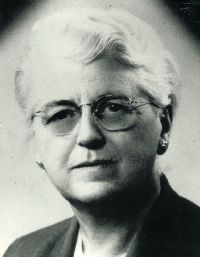Pearl Kendrick facts for kids
Quick facts for kids
Pearl Kendrick
|
|
|---|---|
 |
|
| Born |
Pearl Louella Kendrick
August 24, 1890 |
| Died | October 8, 1980 (aged 90) |
| Alma mater | Syracuse University Johns Hopkins University |
| Scientific career | |
| Fields | Bacteriology, Public Health |
Pearl Louella Kendrick (born August 24, 1890 – died October 8, 1980) was an American scientist. She studied tiny germs called bacteria. Pearl Kendrick is famous for helping to create the first successful whooping cough vaccine. She worked with fellow scientist Grace Eldering and chemist Loney Gordon in the 1930s.
After the whooping cough vaccine was first used, Kendrick helped make sure vaccines were good everywhere. She worked to set vaccine standards in places like Latin America and the Soviet Union. Kendrick and her team also created a special 3-in-1 shot. This vaccine protected against diphtheria, whooping cough, and tetanus. It was called the DTP vaccine and came out in 1948.
Contents
Pearl Kendrick's Early Life and School
Pearl Louella Kendrick was born on August 24, 1890. Her hometown was Wheaton, Illinois, in the United States. She finished high school in 1908. After that, she went to Greenville College for one year. Then, she moved to Syracuse University.
In 1914, she earned her science degree from Syracuse. She studied Zoology, which is the study of animals. Later, in 1932, Kendrick also graduated from Johns Hopkins University. While studying there, she was already working. She was an associate director and chief at the Michigan Department of Public Health.
Researching Whooping Cough
After moving to Michigan, Pearl Kendrick started to research whooping cough. This disease was a big problem at the time. It was very contagious and spreading fast. Records showed that about 6,000 people died from whooping cough each year in the U.S. Most of these deaths, about 95%, were children.
Kendrick worked at a health lab in Grand Rapids, Michigan. There, she met Grace Eldering. Grace was another scientist who also wanted to find a vaccine for whooping cough. They decided to work together to solve this serious health issue.
Developing the Whooping Cough Vaccine
Pearl Kendrick and Grace Eldering led the project to create the vaccine. They planned the research, tested their ideas, and eventually gave the vaccine to children. They went door-to-door in Grand Rapids. They collected samples from children who were sick with whooping cough.
Using these samples, they developed the vaccine. They tested it in an experiment called the "Grand Rapids Trials." During their research, World War II was happening. Many science projects lost their funding. But the First Lady, Eleanor Roosevelt, became interested in their work. She helped them get money from the Works Progress Administration (WPA).
This extra help allowed them to keep working on the vaccine. They studied the results from the Trials for almost three years. The data showed that the vaccine worked! Michigan started giving out the vaccines in 1940. After that, the number of deaths from whooping cough went down. Their work greatly helped in finding whooping cough.
New Vaccines and Modern Impact
In the years that followed, Kendrick, Eldering, and Gordon kept working. They developed a vaccine for three diseases: diphtheria, whooping cough, and tetanus. This was known as the DPT vaccine. For many years, the DPT vaccine was the main way to fight these three illnesses.
Later, in the 1980s and 1990s, people started to have questions about the DPT vaccine. Scientists then created a new version. This new vaccine was called DTaP. It became the main vaccine for diphtheria, whooping cough, and tetanus in the U.S. and other countries. The DPT vaccine created by Kendrick's team helped lead the way for these newer, safer vaccines.
Later Years and Passing
In 1951, Pearl Kendrick retired from the Michigan Department of Public Health. But she didn't stop working entirely. She became a teacher at the University of Michigan. She taught in the Department of Epidemiology. She retired from the university in 1960.
Kendrick also served as the president of the Michigan American Society for Microbiology. She passed away on October 8, 1980, in Grand Rapids.
Awards and Special Honors
In 1983, Pearl Kendrick was honored for her important work. She was added to the Michigan Women's Hall of Fame. This honor recognized her contributions to science and public health.

